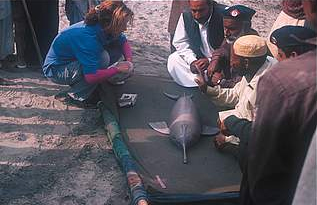The Ganges River Dolphin faces a high risk of extinction in India’s Brahmaputra river system unless critical habitat is protected, report conservationists.
Once abundant in the Ganges and Brahmaputra river systems in India and Bangladesh, the population of the Ganges River Dolphins has fallen sharply over the past century due to accidental bycatch by fishermen, direct killing for their meat and oil, and diversion of water for agriculture. Scientists estimate that only 2,000 remain, of which 240-300 survive in the Brahmaputra, according to a new survey by IUCN researchers, who warn the Brahmaputra population is also imperiled by new threats, including dam building and prospecting for oil.
 Measuring a baby Ganges River Dolphin (Platanista gangetica gangetica). © Gill Braulik |
“Our research shows accidental killing through fisheries by-catch, followed by poaching for oil, are the major threats to the dolphins of the Brahmaputra river system,” says Project Leader Abdul Wakid. “Their habitat is also being degraded by human activities. Dam building and a proposed seismic survey in the Brahmaputra river are potential threats.”
Oil exploration, which would involve using explosives and airguns on the bed of the Brahmaputra River, has “potentially disastrous implications for Ganges River dolphins,” according to the IUCN report, which warns that the loss of dolphins could have impact for local communities that rely on dolphin tourism. IUCN says that involving communities in conservation will be critical to saving dolphins in the Brahmaputra.
PROTECTION OF ENDANGERED GANGES RIVER DOLPHIN IN BRAHMAPUTRA RIVER, ASSAM, INDIA (PDF)














